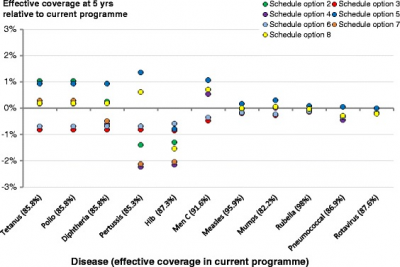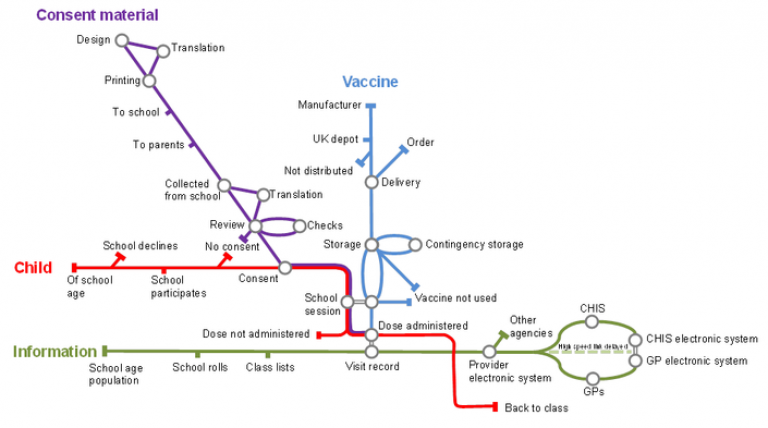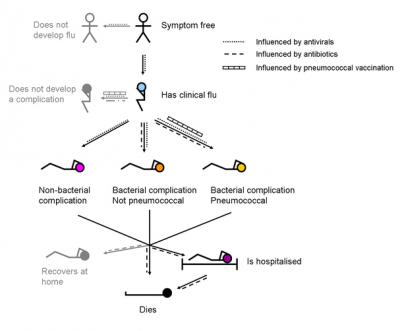CORU staff involved: Christina Pagel, Sonya Crowe, Martin Utley, Luca Grieco
- Tetris (2012 – 2017)
The UK’s routine childhood immunisation programme aims to protect children against a number of preventable infections by offering courses of vaccination scheduled over the first 5 years of life (currently 12 different diseases). The schedule has evolved over time in response to changing circumstances, such as the availability of new vaccines.

Decisions to change the immunisation programme are generally made on a case-by-case basis, but alterations to one aspect of the schedule may have implications for other areas of the programme. For example, there are potential mechanisms whereby adding one or more injections to the schedule could reduce uptake of vaccines that feature later in the schedule. This introduces the scope for changes to the programme having less overall benefit than anticipated - or even causing net harm.
CORU has worked closely with the UK Department of Health to design an overall framework for evaluating a vaccination programme as a whole, that incorporates elements of disease-specific mathematical modelling and cost-benefit considerations.
Selected publications:
- Crowe, Utley, Walker, Panovska-Griffiths, Grove, Pagel, “A novel approach to evaluating a national childhood immunisation schedule”, BMC Infectious Diseases, doi: 10.1186/s12879-015-1299-8, 2015 (Open access)
- Flu Vaccine for children (2013 - 2016)
Evaluating the implementation of vaccinating school-aged children against seasonal influenza (2013 - 2016)
CORU led the evaluation of an evaluation of the implementation of a national programme to immunise school-aged children against seasonal influenza, working with colleagues from the UCL Department of Applied Health Research, the UCL School of Pharmacy and the London School of Hygiene and Tropical Medicine.
The research had 4 strands of activity:
- operational research analysis of the different approaches adopted by provider organisations when delivering immunisation in school settings and of the role of uncertainty in limiting vaccine utilisation;
- organisational ethnography studying the barriers and facilitators experienced by those working to implement the programme at national and local level;
- attitudinal research to capture parental perspectives on aspects of the programme;
- and health economic analysis of implementation costs and of different staffing models

Selected publications:
- Perman S, Turner S, Ramsay AIG, Baim-Lance A, Utley M, Fulop NJ. School-based vaccination programmes: a systematic review of the evidence on organisation and delivery in high income countries. BMC Public Health. 2017;17:252. doi:10.1186/s12889-017-4168-0
- Pandemic preparedness (2010 - 2017)
- Personal protective equipment for healthcare workers

Following an incident involving the release of hazardous materials, ambulance or emergency department staff may need to decontaminate patients prior to treatment. We built models based on queueing theory to estimate the number of powered respirator protective suits should be held by Ambulance Trusts and by Emergency Departments in order to be resilient to potential hazardous events identified locally in community risk registers. This work directly informed guidance issued to Trusts by NHS England concerning procurement decisions worth £10s of millions.
Mass immunisation in an influenza pandemic
The benefits of mass immunisation in an influenza pandemic depends on how infectious and how deadly the pandemic strain is, whether you maintain a stockpile or purchase vaccine in response to the pandemic, how effective the vaccine is, how soon after the start of a pandemic you can start vaccinating people and several other factors. We used an existing model of the impact of immunisation on the number of influenza cases, hospitalisations and deaths to identify the circumstances under which a policy of immunisation is affordable and cost-effective. This work has potential to inform policy concerning new vaccine production technologies as well as supporting decisions between existing policy options, and the code developed to perform our analyses has been handed over to the DH.
Pre-pandemic vaccine
We developed a mathematical model for estimating the number of deaths and hospitalisations that could be avoided by use of a vaccine against pneumonia in the advent of an influenza pandemic. This work directly informed the policy process within Department of Health.Selected publications:
- Crowe, Utley, Walker, Grove, Barlow, Pagel, "A model to evaluate mass vaccination against pneumococcus as a countermeasure against pandemic influenza", Vaccine, doi:10.1016/j.vaccine.2011.04.034, 2011.
- Utley, Pagel, Peters et al., "Does triage at referral to critical care during a pandemic necessarily result in more survivors?", Critical Care Medicine, 39(1): 179-183. 2011
- Grieco, Gleed, Groves, Dyer, Utley, "Informing decisions on the purchase of equipment used by health services inresponse to incidents involving hazardous materials", International Journal of Disaster Risk Reduction 28 (2018) 113-121, doi:10.1016/j.ijdrr.2018.02.036
- Creutzfeld-Jacob Disease
Infection of people with variant Creutzfeld-Jacob Disease due to transfusion of infective blood has happened. However, given the huge uncertainty about the level of VCJD infection in the population, the infectivity of the blood of infected people and the time taken before an infected person displays clinical symptoms, there is considerable uncertainty about the future number of infections from blood transfusion that we will see.
We built a mathematical model, implemented in Microsoft Excel that allowed policy colleagues and expert advisors to explore the implications of different beliefs about uncertain features of the problem on the number of cases we’d have seen to date and the number of future cases. Use of the model contributed to some scenarios that had been considered as “plausible worst cases” being discounted. The model was also used by policy colleagues to explore the impact of additional measures to prevent new infections and informed decisions on the purchase of fresh frozen plasma from abroad. The model was handed over to DH analysts and is still in use. The paper describing this work won an award from the Operational Research Society.
Selected publications:
- Crowe, Bennett, Daraktchiev, Utley, “Use of modelling to inform public health policy: a case study on the blood-borne transmission of variant-CJD”, Journal of the Operational Research Society, 2014, 65(2): 269-277
 Close
Close

